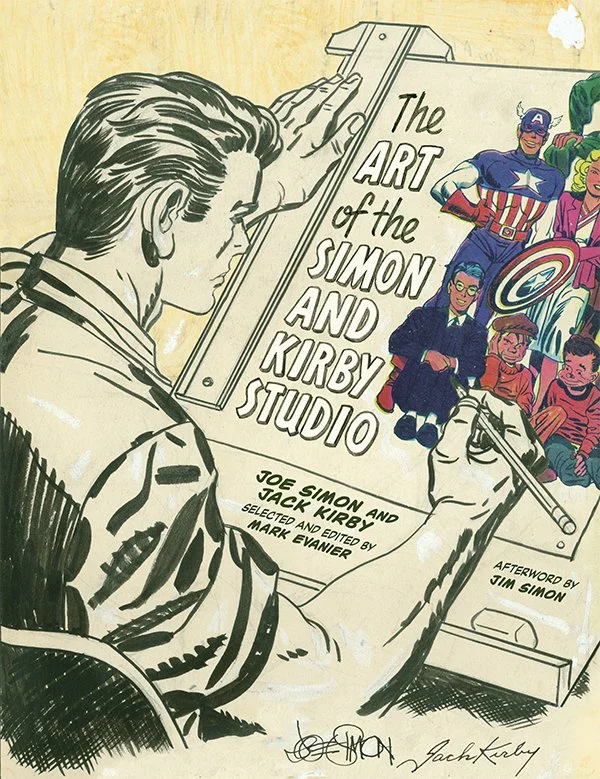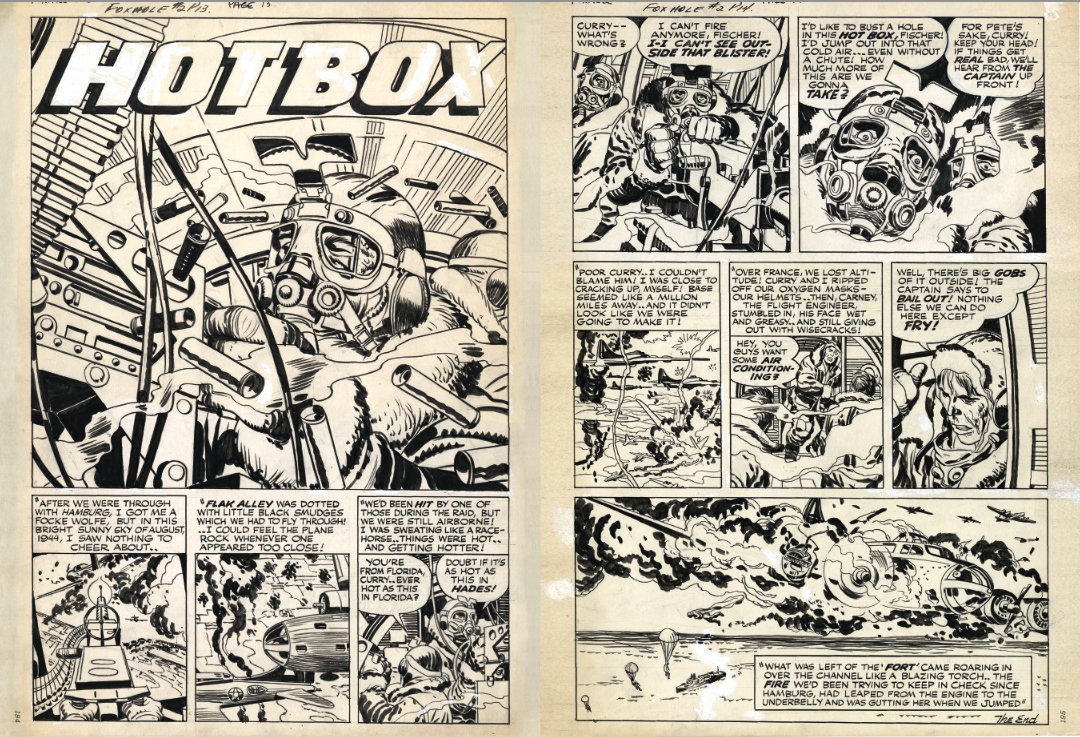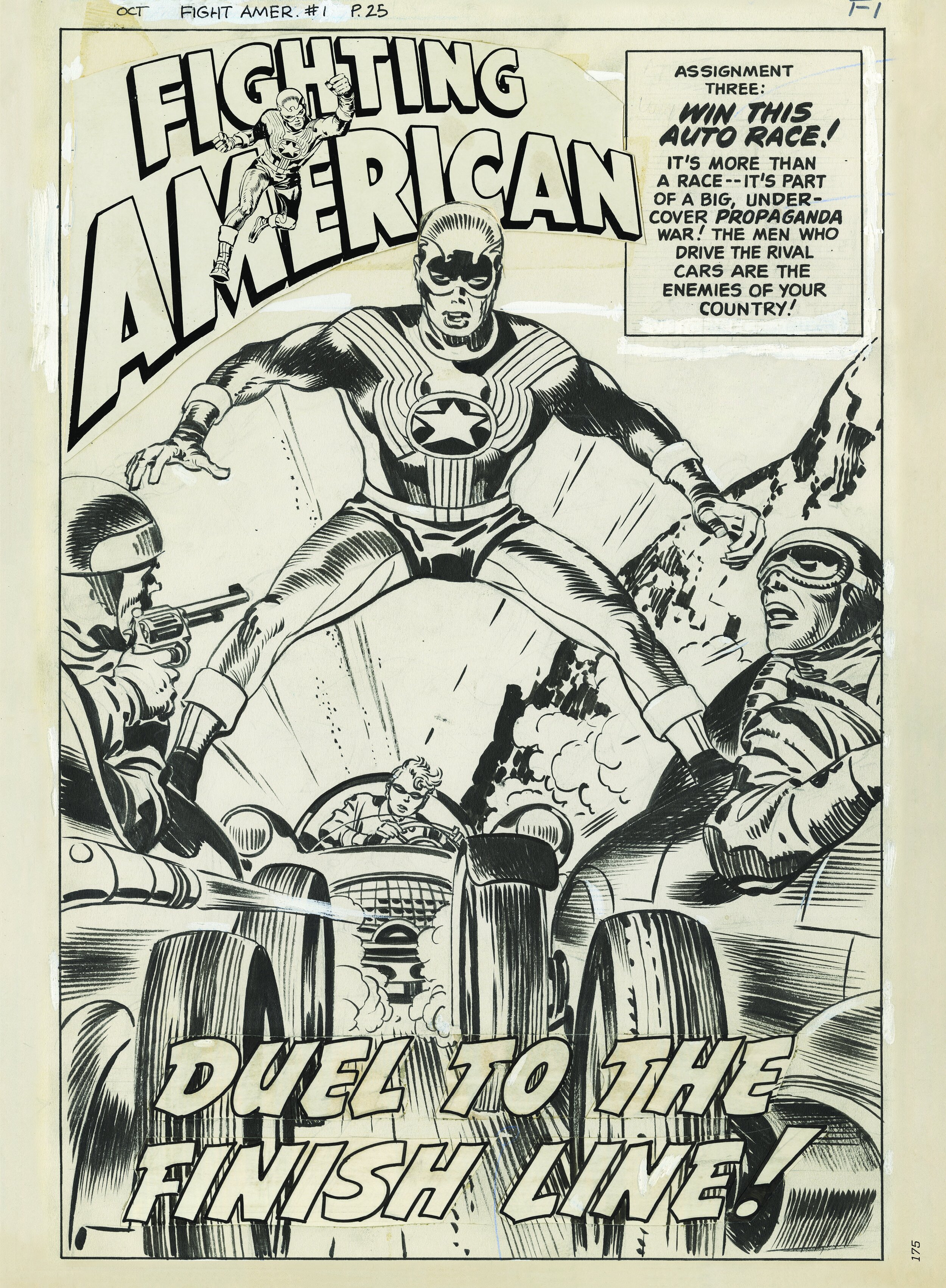Inside Joe Simon and Jack Kirby's Studio
Curated and edited by writer and comics historian Mark Evanier, The Art of the Simon and Kirby Studio is a massive coffee table comics treasury, a volume that celebrates lavishly the process of comics production, and over more than 350 pages spans lesser-known (and sometimes unpublished) work of industry pioneers Joe Simon and Jack Kirby as well as their studio personnel.
It needs to be seen to be believed—Evanier, who worked under Kirby, selected a score of illustration boards from Simon's archive, while Simon, a few years before his death in 2011, suggested that a book of the team's original art be published in this format. Simon's son Jim penned the afterword, which is in parts a moving eyewitness account of all that went into assembling the project.
"Back then," writes Jim Simon in the new book, "the standard practice was that once the art was colored and the printing film made, there was no reason to save the original boards." Joe did, and the originals are reproduced here in a tremendous, nine-by-twelve hardcover, with blots of white correction fluid, errant pencil marks, and other studio-borne blemishes intact. The visible yellowed adhesive tape holds blocky typeface in place on Kirby and Simon's grandiose title pages, the margins of which are seldom without hand-scribbled specs for the printers who would handle the art when they left the team's workspace.
Jack Kirby—legendary co-creator of The Avengers, The X-Men, The Fantastic Four, and more—first met Joe Simon when the latter was hired as an editor for Fox Features Syndicate.
"(I)t's impossible to consider Joe Simon's career without looking at the entire history of the comics business, since he was there almost from the industry's inception," wrote Steven Riggenberg for The Comics Journal in 2011. When they met, Kirby was still Jack Kurtzberg, and was working mostly on a newspaper strip during his day shift while drawing a comics feature at night and selling it elsewhere. The pair's first collaborative effort was the second issue of Blue Bolt for Fox in 1940, the fifth issue of which was signed by Joe Simon and Jack Kirby. Kirby's name change was "no big deal," wrote Evanier in his Eisner Award-winning biography Kirby: King of Comics.
"It was just a desire to sound professional. 'Kurtzberg' didn't sound like a professional and artist. 'Kirby,' he thought, did."
Blue Bolt isn't included in The Art of the Simon and Kirby Studio, but nine other titles are. When Joe Simon left Fox Features, Evanier explains in the book's introduction, the team continued to freelance on joint projects, and Simon took Kirby with him to Timely Comics under publisher Martin Goodman (Timely would later be called Marvel). They worked day shifts at Timely and toiled nightly on other comics at drafting tables in a hotel room near Timely's offices.
Although this duo was responsible for introducing Goodman to their Captain America character in 1941, an unforeseen gargantuan success of a comic (particularly for a debut) that sold millions but would do more for the creators' profiles than their wallets, The Art of the Simon and Kirby Studio celebrates Simon and Kirby's post-Cap features, such as the handful of titles that were produced under their own short-lived publishing house Mainline Comics.
Simon and Kirby produced crime comics, stories about kid street gangs, and actually invented the romance comics genre. The incorporation of Mainline Comics had unfortunately coincided precisely with the widespread 1950s-era rejection of the medium, which sprang from child psychologist Dr. Frederic Wertham's "investigation" and well-publicized tarring of comics (writer Robert Lee Beerbohm cites the trouble that Mainline's distributor, Leader News, weathered at the time for its connections to Wertham target EC Comics). With Mainline's dissolution in 1956, Kirby and Simon's business partnership came to an end.
"In addition to his other talents," wrote Riggenberg of Joe Simon, "he was one of Kirby's best inkers, and their work together is instantly recognizable."
The actual stories collected for The Art of the Simon and Kirby Studio are often ridiculous—soapy and overwrought—and will be of little interest to readers who aren't comics history/Kirby & Simon diehards, but the artistry has aged magnificently.
Emotive facial expressions sometimes fill a panel in the new book, with settings varying widely from the sprawling, rocky backdrop cast for westerns like Boys Ranch to the crowded urban tenement-rimmed stagings in Tough Beat, which are no doubt rooted in the childhood Kirby spent on Suffolk Street in New York City's Lower East Side neighborhood.
A bombastic two-pager from Foxhole called "Hotbox" is staggering, a jittery air-combat tale set within a fighter jet, long cylindrical shell casings whirling amid machine gun barrel smoke in the immediate foreground as if it were meant for 3D.
Nearly each page of the action-oriented comics here packs the same sort of punch, and I can't imagine having experienced this work as a kid, and then revisiting it here in this manner, alongside decades-old work that has never before seen the light of day.
—
The Art of the Simon and Kirby Studio by Joe Simon and Jack Kirby. Selected and with an introduction by Mark Evanier; Afterword by Jim Simon. Published by Abrams ComicArts. All images are copyright the Estates of Joseph H. Simon and Jack Kirby. Fighting American no. 1 (April 1954). Prize Comics. “Duel to the Finish Line!” illustrated by Jack Kirby. Race for the Moon no. 2 (September 1958). Harvey Comics. “The Face on Mars” illustrated by Jack Kirby and Al Williamson. Foxhole no. 2 (December 1954). Mainline Publications. “Hot Box” illustrated by Jack Kirby.



